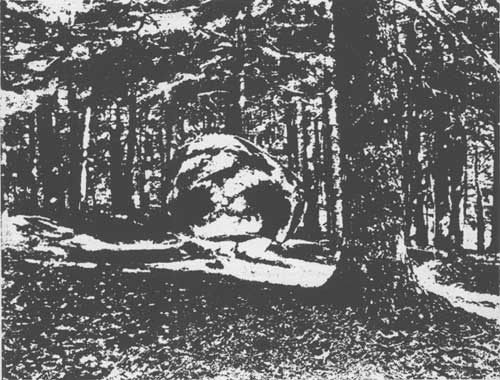|
ACADIA
The Coastal Setting, Rocks, and Woods of the Sieur de Monts National Monument Sieur de Monts Publications IV |

|
THE WOODS OF MOUNT DESERT
By EDWARD L. RAND, Secretary of the New England
Botanical Society and author of "The Flora of Mount Desert."
MOUNT Desert Island has an area of over one hundred square miles. The ocean surges against it on the south; broad bays enclose it on the east and west, and at its northernmost extremity a narrow passage only separates it from the mainland. Its outline is very irregular, like that of the Maine coast in general, with harbors and indentations everywhere. The largest of these, Somes Sound, a long, deep fiord running far into the land between mountainous shores, nearly bisects the island. There are some 13 mountains—bare rocky summits varying in height up to over 1,500 feet and lying in a great belt from east to west; between them deep, blue lakes are sunk in rocky beds. To the north, the northwest and the southeast, the surface—of a different geologic structure—is relatively flat, with lower and more undulating hills and broad stretches of meadow land and marsh. On the southeast and east the mountains approach closely to the shore, ending in a coast of precipitous cliffs and bold, rocky headlands that has long been famous. Nowhere else on the Atlantic coast is there such a wonderful combination of natural scenery as this island possesses; nowhere is there another spot where shore and mountain are so grandly blended. For years it has been renowned as the crowning glory of the beautiful, countless-harbored coast of Maine.

|
| Schooner Head and the entrance to Frenchmans Bay seen from the summit of a splendid cliff. The sea horizon from this point lies over 30 miles away. |

|
| Glacial boulder in a forested mountain valley 700 feet above the sea. |
The forests of Mount Desert Island were once full of wealth, and full of wealth they still would be if the lumbermen had not done their work so well. High up on the mountain sides, through the mountain gorges, along the borders of the lakes and streams, everywhere to the water's edge, the great trees growing on the thin but rich wood-soil were taken out, as one may plainly see by their huge rotting stumps to-day. The importance of preserving the woods which still remain no lover of Nature can question. They are infinitely precious as a part of the wild scenery of the place and for their wonderful attraction to the city-wearied man or woman in search of a summer home and resting-place.
What the island was in the early days of its primeval beauty, when Champlain sailed along its shore and for a century after, lies far beyond the possibility of conjecture now. Yet some idea of what these woods once were may still be gained from a few favored spots where portions of the ancient forest yet remain, and much of their original beauty may be brought back if steps are taken to preserve them now and protect from consuming forest fires the all-important humus in their soil.
| <<< Previous |
sieur_de_monts/4/sec4.htm
Last Updated: 24-Mar-2010